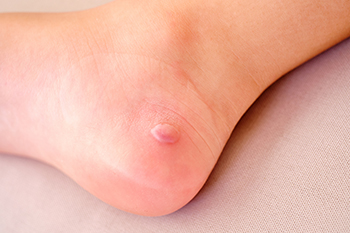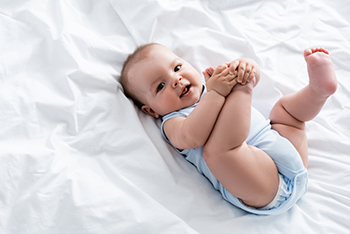Items filtered by date: November 2024
Facts About Foot Blisters

Foot blisters are small, fluid-filled sacs on the skin, that typically form due to friction, heat, or moisture. They most commonly develop on the feet while running, hiking, or walking long distances. The repeated rubbing of shoes against the skin causes the outer layer of the skin to separate, leading to a buildup of fluid underneath. Blisters can also form if the feet become excessively sweaty or if wearing ill-fitting shoes causes pressure on certain areas of the foot. Although generally not serious, foot blisters can be painful and make walking or running uncomfortable. To prevent blisters, it is important to wear properly fitted shoes, keep the feet dry, and use blister prevention products such as socks designed for moisture wicking or blister pads. Foot blisters can easily become infected, causing pain and discomfort. If this has happened to you, it is suggested that you consult a podiatrist who can offer you relief and prevention methods.
Blisters are prone to making everyday activities extremely uncomfortable. If your feet are hurting, contact Derek Smith, DPM of Oklahoma. Our doctor can provide the care you need to keep you pain-free and on your feet.
Foot Blisters
Foot blisters develop as a result of constantly wearing tight or ill-fitting footwear. This happens due to the constant rubbing from the shoe, which can often lead to pain.
What Are Foot Blisters?
A foot blister is a small fluid-filled pocket that forms on the upper-most layer of the skin. Blisters are filled with clear fluid and can lead to blood drainage or pus if the area becomes infected.
How Do Blisters Form?
Blisters on the feet are often the result of constant friction of skin and material, usually by shoe rubbing. Walking in sandals, boots, or shoes that don’t fit properly for long periods of time can result in a blister. Having consistent foot moisture and humidity can easily lead to blister formation.
Prevention & Treatment
It is important to properly care for the affected area in order to prevent infection and ease the pain. Do not lance the blister and use a Band-Aid to provide pain relief. Also, be sure to keep your feet dry and wear proper fitting shoes. If you see blood or pus in a blister, seek assistance from a podiatrist.
If you have any questions, please feel free to contact our offices located in Ponca City, and Stillwater, OK . We offer the newest diagnostic and treatment technologies for all your foot care needs.
Let the Expert Treat Your Ingrown Toenails
Causes of Falls in Older Adults

Falls are a frequent and dangerous risk for seniors, often linked to foot health and mobility factors. Conditions like diabetes, foot pain, arthritis, and balance challenges can affect a person’s stability, raising the chance of falls. With age, loss of muscle strength and decreased flexibility in the feet can affect balance, while issues such as bunions, hammertoes, and arthritis may lead to discomfort and an unsteady gait. Additionally, wearing improper footwear, including high heels or backless shoes, can increase the risk of falling by failing to provide adequate foot support. A podiatrist can be instrumental in addressing these issues by assessing foot health, prescribing custom orthotics or walking aids, and recommending suitable footwear to improve stability. Regular foot exams allow for the detection of early changes that may affect balance, making it possible to implement interventions that reduce fall risk. If you are a senior at risk of falling, it is suggested that you schedule an appointment with a podiatrist for an evaluation and suggested treatment.
Preventing falls among the elderly is very important. If you are older and have fallen or fear that you are prone to falling, consult with Derek Smith, DPM from Oklahoma. Our doctor will assess your condition and provide you with quality advice and care.
Every 11 seconds, an elderly American is being treated in an emergency room for a fall related injury. Falls are the leading cause of head and hip injuries for those 65 and older. Due to decreases in strength, balance, senses, and lack of awareness, elderly persons are very susceptible to falling. Thankfully, there are a number of things older persons can do to prevent falls.
How to Prevent Falls
Some effective methods that older persons can do to prevent falls include:
- Enrolling in strength and balance exercise program to increase balance and strength
- Periodically having your sight and hearing checked
- Discuss any medications you have with a doctor to see if it increases the risk of falling
- Clearing the house of falling hazards and installing devices like grab bars and railings
- Utilizing a walker or cane
- Wearing shoes that provide good support and cushioning
- Talking to family members about falling and increasing awareness
Falling can be a traumatic and embarrassing experience for elderly persons; this can make them less willing to leave the house, and less willing to talk to someone about their fears of falling. Doing such things, however, will increase the likelihood of tripping or losing one’s balance. Knowing the causes of falling and how to prevent them is the best way to mitigate the risk of serious injury.
If you have any questions, please feel free to contact our offices located in Ponca City, and Stillwater, OK . We offer the newest diagnostic and treatment technologies for all your foot care needs.
Causes and Symptoms of Bunions

A bunion is a bony bump that forms on the joint at the base of the big toe, typically due to misalignment of some of the bones in the front of the foot. This misalignment can force the tip of the big toe toward the smaller toes, causing the base of the joint to protrude. Common causes of bunions include wearing tight or narrow footwear, hereditary foot shapes, and medical conditions like arthritis. Symptoms include swelling, redness, and persistent pain at the big toe joint. A podiatrist can assess the severity of the bunion and recommend appropriate treatment options. Non-surgical choices include wearing shoes with a wider toe box, using protective pads, or applying orthotic devices to redistribute pressure. If non-surgical measures are ineffective, surgery may be considered to realign the bones or remove inflamed tissue. If you have developed a bunion that is causing pain, it is suggested that you schedule an appointment with a podiatrist for an exam and treatment.
If you are suffering from bunions, contact Derek Smith, DPM of Oklahoma. Our doctor can provide the care you need to keep you pain-free and on your feet.
What Is a Bunion?
A bunion is formed of swollen tissue or an enlargement of boney growth, usually located at the base joint of the toe that connects to the foot. The swelling occurs due to the bones in the big toe shifting inward, which impacts the other toes of the foot. This causes the area around the base of the big toe to become inflamed and painful.
Why Do Bunions Form?
Genetics – Susceptibility to bunions are often hereditary
Stress on the feet – Poorly fitted and uncomfortable footwear that places stress on feet, such as heels, can worsen existing bunions
How Are Bunions Diagnosed?
Doctors often perform two tests – blood tests and x-rays – when trying to diagnose bunions, especially in the early stages of development. Blood tests help determine if the foot pain is being caused by something else, such as arthritis, while x-rays provide a clear picture of your bone structure to your doctor.
How Are Bunions Treated?
- Refrain from wearing heels or similar shoes that cause discomfort
- Select wider shoes that can provide more comfort and reduce pain
- Anti-inflammatory and pain management drugs
- Orthotics or foot inserts
- Surgery
If you have any questions, please feel free to contact our offices located in Ponca City, and Stillwater, OK . We offer the newest diagnostic and treatment technologies for all your foot care needs.
Barefoot Babies

Allowing babies to go barefoot offers numerous benefits that contribute to their overall development. When infants walk without shoes, they enhance their awareness of their surroundings, as their feet can feel different textures and temperatures. This sensory experience plays a vital role in brain development and spatial awareness. Furthermore, being barefoot encourages natural foot development, allowing the arches to form properly and strengthening the muscles and ligaments in the feet. As babies navigate different surfaces, they improve their coordination and agility, essential skills for later stages of physical activity. This freedom also fosters balance, helping them gain confidence as they explore their environment. Embracing the barefoot experience not only supports healthy foot growth but also nurtures a sense of exploration and movement that can positively influence their development. If your baby has any type of foot problem, it is suggested that you consult a podiatrist who can treat various foot conditions and guide you on additional benefits of babies walking barefoot.
The health of a child’s feet is vital to their overall well-being. If you have any questions regarding foot health, contact Derek Smith, DPM of Oklahoma. Our doctor can provide the care you need to keep you pain-free and on your feet.
Tips for Keeping Children's Feet Healthy
- Make sure their shoes fit properly
- Look for any signs of in-toeing or out-toeing
- Check to see if they have Clubfoot (condition that affects your child’s foot and ankle, twisting the heel and toes inward) which is one of the most common nonmajor birth defects.
- Lightly cover your baby’s feet (Tight covers may keep your baby from moving their feet freely, and could prevent normal development)
- Allow your toddler to go shoeless (Shoes can be restricting for a young child’s foot)
- Cut toenails straight across to avoid ingrown toenails
- Keep your child’s foot clean and dry
- Cover cuts and scrapes. Wash any scratches with soap and water and cover them with a bandage until they’ve healed.
If you have any questions, please feel free to contact our offices located in Ponca City, and Stillwater, OK . We offer the newest diagnostic and treatment technologies for all your foot care needs.

